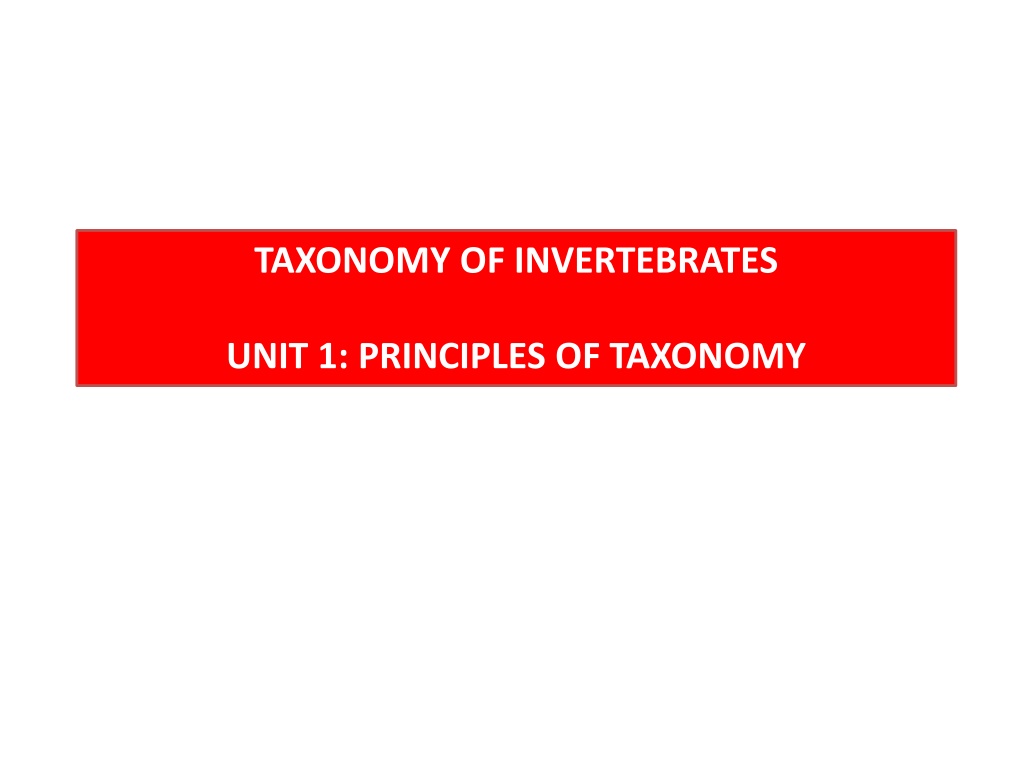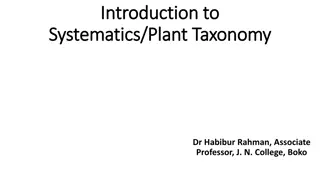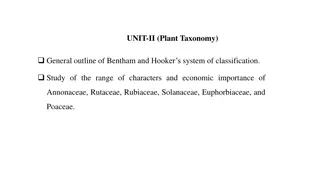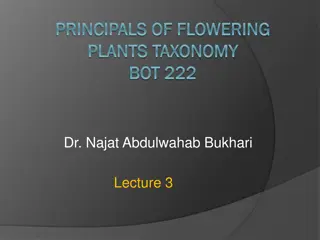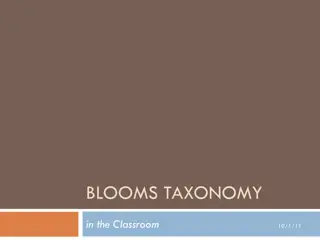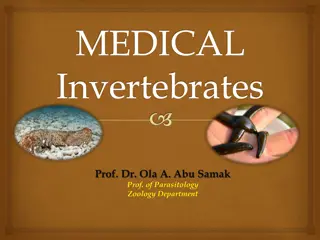Principles of Invertebrate Taxonomy
Levels of organization in invertebrates, from unicellularity to multicellularity, exploring colonies and the benefits of multicellularity. Learn about acellular organisms and the various levels of organization within multicellular organisms.
Download Presentation

Please find below an Image/Link to download the presentation.
The content on the website is provided AS IS for your information and personal use only. It may not be sold, licensed, or shared on other websites without obtaining consent from the author.If you encounter any issues during the download, it is possible that the publisher has removed the file from their server.
You are allowed to download the files provided on this website for personal or commercial use, subject to the condition that they are used lawfully. All files are the property of their respective owners.
The content on the website is provided AS IS for your information and personal use only. It may not be sold, licensed, or shared on other websites without obtaining consent from the author.
E N D
Presentation Transcript
TAXONOMY OF INVERTEBRATES UNIT 1: PRINCIPLES OF TAXONOMY
UNIT 1: PRINCIPLES OF TAXONOMY 1.1 Levels of Organization Unicellularity, Colonization of cells and multicellularity. a) Unicellularity (Single cell) It can be eukaryotic or prokaryotic. Prokaryotic cells do not have membrane bound nucleus. Eukaryotic cells have membrane bound nucleus. The examples of unicellular organisms are bacteria, protozoa, unicellular algae, unicellular fungi etc. All vital functions are carried out within single cells. Their reproduction may be sexual or asexual. Unicellular organisms are believed to have formed 3.8 billon years. They do not have tissues or organs.
1.1 Levels of Organization b) Colonization It is an advancement towards collection of organisms in close association to form a colony. It is done for establishment in the ecosystem and to prevent extinction. It is useful for mutual benefits of unicellular organisms, for stronger defense and attack bigger prey and reproduction. The colony may be of similar individuals or different individuals. In the colony, the division of labour is well organized. The members of the colony are united as like sponges or coelenterates or may differentiated in castes as in ants, bees etc.
1.1 Levels of Organization c) Multicellularity Multicellular organisms are made up of more than one cells. Example : All plants, animals and higher life forms are multicellular organisms. Benefits of multicellularity 1. Bigger size of organism 2. Complexity and division of labour i.e. different types of cells perform different functions at a definite place in the body. 3. According to colonial theory, the metazoans are evolved from colonial flagellate or amoeboid protozoan. 4. According to colonial theory, the process of colonization leads to multicellularity. The cells are differentiated into somatic cells and germ cells.
1.1 .3. Levels of Organization The multicellular organisms have various levels of organization in their body. Individual cells perform different functions and also work together. The cells are also dependent on each other. Multicellular organisms have following 5 levels of organization Cells Tissues Organs Organ systems Different organisms exhibit following levels of organization 1. Acellular 2. Cellular 3. Tissue 4. Organ 5. Organ system Organisms
1. Acellular They do not contain any cell membrane, cytoplasm and cell organelles. It is seen in viruses, viroids, plamids, phagmids, cosmids, transposons and prions. They do not reproduce or replicate on their own. They are completely depend on host for reproduction and lack enzymes for energy production. They can not grow, develop or metabolize. They possess either DNA or RNA , not both as in the living cells. They utilize ribosomes and enzymes of host.
2. Cellular According to cell theory (1839) , all living organisms are composed of one or more cells. Cell is a basic unit of structure and function of living beings. A lowest level of organization in the metzoans is cellular grade of organization. It is seen in sponges. Individual cells differentiate during development to perform special functions but not associated to perform collective function. They are different types of cells exhibiting division of labour Examples: Pinacocytes, Choanocytes, Porocytes, Scleroblasts etc. Cells serve specific function within the multicellular organism such RBCs, WBCs, Neuron cells, Bone Cells etc.
3. Tissue Level Tissue is made up of cells that are similar in structure and function. They work together to perform specific activity. Example : Connective tissue, muscle and nerve tissue Humans have four basic tissues viz. connective, epithelial, muscle and nerve tissue. These different cell types form specialized tissue. Example : The first true metazoan phylum of tissue grade organization is Cnidaria or Coelenterata. The cells performing similar functions are highly coordinated and are aggregated into tissues. The functions of different tissues is also coordinated. They posses network of nerves. They transmit impulse and maintain coordination.
4. Organ Level Organ is grouped of two or more tissues. They perform specific function for the organism such as heart, brain, skin etc. Platyhelmiinthes are the first which show the organ level of organization. Platyhelminthes are triplobastic animals as they show three layers viz. ectoderm, mesoderm and endoderm.
5. Organ System Level In higher organisms well organ grade system is developed which performs specific functions Example : Digestion, Respiration, Circulation, Excretion and Reproduction. It is first seen in a group of marine worms known Aschelminthes and Annelids having circulatory system, nervous system etc. This highest level of organization is seen in Human body with 11 Organ System. They are Circulatory, Digestive, Endocrine, Excretory, Immune, Integumentory, Muscular, Nervous, reproductive, respiratory and skeletal system.
SYMMETRY THE QUALITY OF AN ORGANISM BEING MADE UP OF EXACTLY SIMILAR PARTS FACING EACH OTHER OR AROUND AN AXIS IS CALLED AS SYMETRY. Types of Symmetry 1. Asymmetry 2. Radial symmetry 3. Bilateral Symmetry 4. Asymmetry Lack or absence of symmetry is called as asymmetry. Example : Amoeba It posses irregular body shape and hence have no symmetry. Amoeba produce elongated structures called pseudopodia for feedig and locomotion. It can be produced from any surface of the membrane for short duration. Once it s function is over it comes back to its original position.
2. Radial Symmetry If the body of an organism can be divided into two equal halves by vertical plane passing through the central axis, it is called as radial symmetry. Example : Star fish At the intial stages of development star fish shows bilateral symmetry. However during metamorphosis they lose this bilateral symmetry and develop radial symmetery , most often pentamerous symmetry but other symmetries are also common.
3. Bilateral Symmetry If Longitudinal plane passes through the axis of the body of animal and separate it in equal right and left sides, it is termed as mid sagital plane. When body parts are arranged in roughly mirror image halves along mid-sagitual plane, it is known as Bilateral Symmetry. Example 1. Invertebrate - Planaria 2. Vertebrate - Man
EVOLUTIONARY SIGNIFICANCE OF SYMMETRY Symmetry has evolved for unidirectional, purposeful and intentional movements towards food or better locations or away from danger. Radial symmetry helps the animals for collecting food and defense but bilateral symmetry maximized the necessary force to change direction. This gave a selective advantage to the bilateral animal during evolution as compared to other symmetry types. Approximately 99% of animal species are bilaterally symmetrical. Bilateral symmetry has first developed in flat animals. Bilateral symmetry helped the animal to become fit for survival, since it is significant for prey, for predators as well as in finding food and mate.
1.3 Coelom 1.3.2. Basic concept and definition The term coelom is derived from the greek word Koilia meaning cavity . Coelom is a fluid filled body cavity which is completely lined by mesoderm. Coelom is found in multicellular, bilateral and triplobalstic organisms.
Types : There are three types of triploblastic animals based on the presence of coelom and they are Acoelomates- Animals without a coelom. e.g. flat worms (Liver fluke ) Coelomates Animals have coelom. e.g. All chordates Pseudocoelomates- Animals posses a cavity called as false coelom between the gut and body wall. e.g. Nematodes, Rotifers
Formation of Coelom Triploblastic animals have three germ layers 1. Outer ectoderm 2. Middle mesoderm 3. Inner endoderm Formation of Coelom Triploblastic animals show two ways of coelom formation i.e. Schizocoely and Enterocoely. 1. Schizoceoly: In this process coelom arises by splitting mesoderm during embryonic development. e.g. Mollusca, Sipuncula, Annelida, Arthropoda and Onychopohora
2. Enterocoely It is the process in which coelom is formed by the evagination of pouch like structures from the embryonic archenteron. These pouches with central cavity get detached from archenteron, enlarge and occupy the whole body as coelom. e.g. Echinodermata, Hemichordata and chordata. 3. Myocoel The mesencyme rearranges to enclose a space i.e. coleom called myocoel. It is a rare method neither enterocoelus nor schizocoelus e.g. seen in Phoronidans.
EVOLUTIONARY SIGNIFICANCE OF COELOM 1. Protect organs from shock and injury. 2. Coelomic fluid assists the body processes and acts as a hydroskeleton. 3. It serves for transport of gases, nutrients and waste products between different parts of the body. 4. It allows storage of sperms and eggs during maturation and it acts as a reservior and helps for removal of waste. 5. Coelom allows internal organs to change shape, as they grow and move indpendantly of outer body wall, creating more physiologhical and evolutionary flexibility.
Metamerism It is a body plan in which the similar body segments and organ systems are serially repeated one after another. When the body of animal has linear series of repeating parts from anterior up to posterior end, it is called as segmentation or metamerism segmentation. The similar body segments are called metamers or segments. or metameric Metameism is present in phylum Annelida, Arthropoda and Chordata. In animal kingdom, metamerism is first seen in Annelids.
Types of Metamerism There are two types of metamerism is found in animals. 1. Pseudometamerism : In pseudometamerism or strobalization, the segmentation of ectoderm is the main cause of metamerism. In this type, segments have different shapes and numbers in the individuals of same species. Example : Tapeworm
True Metamerism In true metameism, segmentation of the body is due to the segmentation of the mesoderm. True metamerism is in coordination within the segments. The new segments are formed at posterior end of the body. New segments are not added after maturation. Examples: true segments are found in Annelida, Arthropoda and Chordata. There are two type of true metamerism. 1. Homonomous metamerism 2. Heteronemous metamerism
1. Homonomous Metamerism If the segments of the animal are all alike, the segmentation is called as homonemous segmentation. It is primitive type of segmentation. Exmaple : Nereis 2. Heteronemous Metamerism In higher invertebrates, such as arthropods, all segments or metameres are not similar but are fused and modified for specific function such as head, thorax and abdomen. Such metamerism is called heteronemous metamerism. There are two types of heteronemous metamerism 1. Cephalization : Insecta : Dragonfly 2. Cephalothorax: Crustacea: Lobster
1. Cephalization There is a union of few segments to form head. The concentration of nervous control, sensory and feeling organs at the anterior end of the body to develop head is called as cephalization. Example: Insecta: Dragonfly 2. Cephalothorax The body of some segmented animals show heteronemous segmentation and consist of two parts : the cephalothorax and abdomen. Cephalothorax shows fusion of head with thoorax Ex. Merostoma , Arachnida
Evolutionary significance of Metamerism 1. Helps in locomotion. 2. Independent segmental movement is possible. 3. Development of greater complexity in structure and function. 4. Allow better flexibility and increased burrowing efficiency of burrowing animals. 5. Metamerism offers division of labour. 6. Protect Sensitive organs from damage.
1.5 Taxonomy 1.5.1. Basic Concept, definition and objectives Greek Word Taxis means Arrangement or Division and nomos means law or method . The term taxonomy was introduced in 1813 by Candolle. Taxonomy is the science of classification of organisms on the basis of their phenotypic characteristics. Classification of organisms is based on the similarities of characters between different organisms. Swedish Botanist Carl Linnaeus (1707-78) developed a system of classification of organisms and it is known as Linnaenian Classification for categorization of organisms and binomial nomenclature for naming organisms. Taxonomy is the dynamic branch of biology, moreover use of new techniques for classifying organisms e.g. Molecular biological techniques, like DNA hybridization, determination of homology of ribosomal RNA s have made a great impact on the taxonomy.
1.5 Taxonomy 1.5.2. Linnaean Hierarchy Hierarchy means different levels in classification. Each level of classification is called a taxon (plural is taxa). A taxonomic hierarchy is created by forming groups of similar organisms called taxa and then the animals from the same taxon with some different characteristics are segregated to form a subgroup of lower rank. Each level or rank has a different designation and these ranks form a hierarchial arrangement. This system of different ranks is called as Linnaean Hierarchy. A given taxon may contain several lower taxa, which can be distinguished on certain common characters. The lower ranks are further divided into smaller ranks.
1.5 Taxonomy 1.5.2. Linnaean Hierarchy More similarity in organisms means rank or taxon of the group is lower. For all living organisms, the biggest taxonomic rank is Kingdom, the next rank within the kingdom is Phylum or Division grouping closely related organisms with common characteristics. Each phylum has next taxon called Class. The members of each class display certain unique distinguishing characters. In the same way each class is divided into orders Each order into families Each family into genera Each genera into species Species is the basic or fundamental unit of classification. Kingdom is wide ranging category and species is smallest taxonomic category in the Linnaean Hierarchy.
1.5 Taxonomy 1.5.2. Linnaean Hierarchy A typical Linnaean Hierarchy has seven taxa. Sometimes an additional rank is required to be introduced between two ranks. A prefix sub or super is added to such new ranks for example, between two taxa ; phylum and a class, there is subphylum or a Superclass. Thus, the extended Linnaean hierarchy may consist of twelve ranks
Binomial Nomenclature The main aim of the taxonomy is to assign each organism a name that all scientists can use. This naming is known as nomenclature. It was first introduced by Carl Linaneus in 1753. This name has two parts a. Genus name for a small group of colsely related organisms b. Species a name to identify particular species as separate from others but belonging to the same genus Hence such nomenclature is called a binomial nomenclature. Both names must be in Latinized form. The genus name is written first with capital letters and the species name is written next in small hand. Generic and specific names are italicized. To avoid, confusion, a scientific name of an organism also requires the citation of the author s name who first proposed the name.
1. ARCHAEBACTERIA UNICELLULAR PROKARYOTIC 6. ANIMALIA- MULTICELLULAR . EUKARYOTIC 2. EUBACTERIA UNICELLULAR PROKARYOTIC SIX KINGDOM CLASSIFICATION 5. PLANTAE- MULTICELLULAR, EUKARYOTIC 3.FUNGI- MULTICELLULAR EUKARYOTIC 4. PROTISTA- UNICELLULAR/ MULTICELLULAR
In 1998, Cavalier- Smith published a six kingdom model, later modified by Carl Woese. Based on the sequence of 16 S ribosomal RNA genes, Woese found that six kingdom naturally cluster into three main categories. He called these categories as domains. The six kingdoms are Archaebacteria, Eubacteria, Protista, Fungi, Plantae and Animalia.
GENERAL CHARACTERS OF EACH KINGDOM WITH EXAMPLES 1. KINGDOM ARCHAEBACTERIA Archae means Ancient. These are single celled prokaryotes having a unique robosomal RNA type. Archaebacteria can undergo anaerobic respiration that produces methane, For example Thermophiles, Psychriphiles. Methanogenes, Halophiles, Depending up on the species, they may need oxygen, hydrogen, carbon dioxide, sulfur or sulfide for metabolism. Nutrition intake may be by absorption, non- photosunthetic phosphorylation , or chemosynthesis. Reproduction by sexual or asexual method.
2. Kingdom Eubacteria These are true bacteria which live in every type of environment. Most bacteria do not cause disease. These are prokaryotic, microscopic with varied shapes which reproduce asexually by binary fission as a fast rate under favorable conditions. Oxygen may be toxic, tolerated or needed for their metabolism. Nutrition intake may be by absorption, photosynthesis, or chemosynthesis. Reporduction is asexual for example Cyanobacteria (Blue Green algae), Actinobacteria etc.
3. Kingdom Protista Includes diverse gourp of unicellular eukaryotic organisms. They have mitochondria, some have chloroplasts. They need oxygen for metabolism Nutrition intake may be by absorption, ingestion or photosynthesis. Reproduction is mostly asexual. Meosis occurs in some species. They may be commensal or mutual in rlationships with their host or parasite. Examples : Amoeba, Green Alga, Brown Alga, Diatom, Euglena, Slime Molds etc.
4. Kingdom Fungi Unicellular or multicellular, eukaryotic, heterotrophic mostly non- moitile organisms. Body is composed of coenocytic hyphae except few unicellular fungi. They need oxygen for metabolism. Reproduction is vegetative or asexual through spore formation or sexual. Examples Mushrooms, Yeast, Molds.
5. Kingdom Plantae Multicellular containing various types of cells. Cells possess cellulose in cell wall. Mostly autotrophs, found on land or in aquatic medium. They epiphytic, symbiotic or parasitic Plants are extremely important for life on earth. They provide oxygen, foood, shelter, clothing, medicine for other living organisms. This diverse group contains vascular and non vascular, flowering and non flowering, seed bearing and non seed bearing plants. Reproduction by vegetative, asexual or sexual method.
5. Kingdom Animalia Multicellular heterotrophic and eukaryotic organisms. They live in aquatic medium or on terrestrial environments. Size may be small to extremely large. Body wall may be diplobastic or triploblastic. Oxygen is needed for metabolism. Nutrition is holozoic acquired by ingestion. Generally they have power of locomotion; few groups are sessile and sedentary. They have nervous system except sponges. About 34 phyla are placed under Kingodm Animalia. Examples are Porifera, Platyhelminthes, Mollusca, Chordata.
